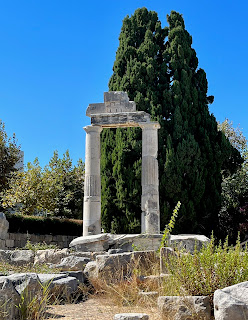We are staying on the Greek island of Kos this week. One of the Dodecanese Islands is a stone's throw from Turkey, or these days potentially something more lethal! It is more than a bit warmer than Scotland, but pleasant breezes here on the beach. Or, more accurately, my wife is on the beach while I retreated to the bar!
Yesterday, I walked around Kos Town. This is an ancient Greek island. In Homer's Iliad, a contingent of Koans fought for the Greeks in the Trojan War, and the 'Father of Medicine,' Hippocrates, was born here.
 |
| One of the best collections of Mycenean weapons I have seen in the Archeological Museum |
The Persians occupied the island for a while, and Kos was held by the Ptolemies, who used it as a naval outpost to oversee the Aegean. Then the Romans arrived, and there are plenty of their (and Greek) remains in the town and the Museum.
The number one attraction is the Nerantzia Castle. It occupies the spit of land that forms the natural harbour. There would have been Greek and Roman forts to guard the harbour, but the castle was built at the end of the 14thC by the Knights of St John, who leased the island from the Genoese. From the outside, it doesn't look that impressive. The walls look pretty low, although the modern port berths are probably higher.
In 1566, the Ottomans captured the town and held it until 1911. Orlov turned up with the Russian fleet in 1773 but failed to capture the castle. There is still a small Turkish population on the island and a few signs of the Ottoman period.








Hmmm! Good time to go. Just when it's turned cold here and the schools have gone back. So much history for such a small place.
ReplyDeleteThe weather looks lovely - although, to be fair, there is bright sunshine in our garden in the UK at the moment. I suspect it will be a lot warmer for you though. Have a good time and take plenty of photos 👍
ReplyDeleteCheers,
Geoff
The schools may be back, but parents with young children come out now. Says Mr Grumpy!
ReplyDelete